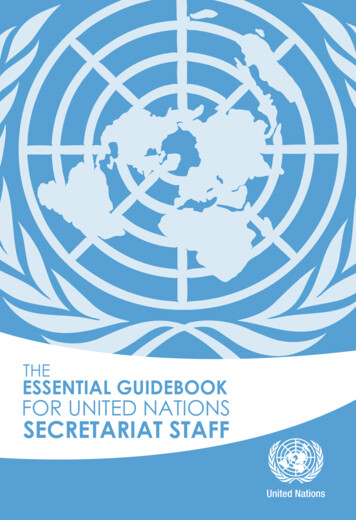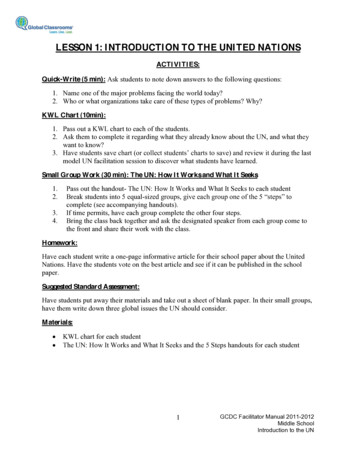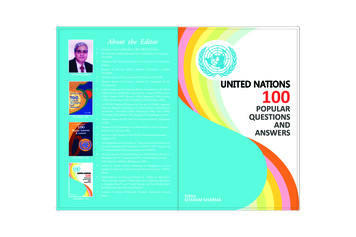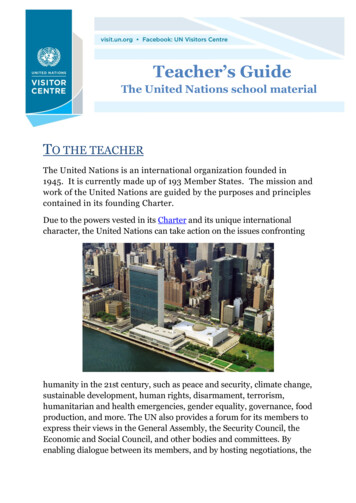
Transcription
Protocols for usingFirst Nations Cultural andIntellectual Property in the Arts
Australia Council for the ArtsLevel 5, 60 Union Street, Pyrmont NSW 2009, AustraliaPO Box 576, Pyrmont NSW 2009, AustraliaABN 38 392 626 187Telephone: 02 9215 9000Toll-free: 1800 226 912Email: liacouncil.gov.au Australia Council 2019, compiled documentFirst published 2002, edited and revised in 2007 and 2019. This workis copyright. Apart from any use as permitted under the CopyrightAct 1968 (Cth), no part may be reproduced by any process withoutprior written permission from the Australia Council.Requests and enquiries about reproduction and rights should beaddressed to the Aboriginal and Torres Strait Islander Arts teamat FirstNationsArts@australiacouncil.gov.au True Tracks ICIP Principles, Dr Terri Janke and Company.The principles used in this document are based on theTrue Tracks Principles.Front cover image compiled with: Broken Glass photo - Lily Shearer,Liza-Mare Syron and Katie Leslie. Credit Joshua Morris;Joel Bray and Damion Hunter in Djurra – a NORPA Production,Credit: Kate Holmes;Polly Hilton, Darren Edwards, Claire Voss, Christian Luck, Catherine Youngand Oliver Edwardson in Milnjiya, Milky Way – River of Stars, image courtesyof West Australian Ballet. Credit Sergey Pevnev.
AcknowledgementsDr Terri Janke and Company would like to acknowledge the input of AustraliaCouncil for the Arts staff who have guided the development of this third editionof the protocol guide, namely: Frank Panucci, Former Executive Director, Grants and Engagement Lydia Miller, Executive Director, Aboriginal and Torres Strait Islander Arts Patricia Adjei, Head of Practice, First Nations Arts and Culture Jeremy Smith, Former Director Community, Emerging and Experimental ArtsAustralia Council for the Arts staff members who attended and contributed tothe consultation workshop on 16 October 2018, particularly First Nations staffmembers including Anastasia Charles, Ian RT Colless and former staff memberRei Cheetham.Dr Terri Janke (Solicitor Director), Maiko Sentina (Solicitor) and Gabriela Dounis(Research Assistant) of Dr Terri Janke and Company undertook the 2018–2019edits of the guides. Laura Curtis (Solicitor) and Desiree Leha (Solicitor) ofDr Terri Janke and Company also assisted with drafting and research.We acknowledge all the contributors and peer reviewers who helped shaped thefirst and second editions (2002 and 2007) of this protocol guide. This editionconsolidates the five protocol guides into one guide in recognition of, and to keepabreast with, the constantly evolving nature of the Australian creative landscape.i
We would like to thank the following people for contributing their valuable time,insight and information to the case studies. These include: Jonathan Jones for the untitled (giran) case study. Diann Lui (Manager, Erub Arts) for the Caught in the Net case study. Anna Moulton (CEO, Magabala Books) and Rachel Bin Salleh (publisher,Magabala Books) for the Indigenous-led storytelling and writingcollaborations case study. Tara June Winch for The Yield case study. Jessie Lloyd for the Mission Songs Project case study. Kirk Page (former Associate Director, Northern Rivers Performing Arts) andPatrick Healey (General Manager, Northern Rivers Performing Arts) for theDjurra case study. Lily Shearer and Liza-Mare Syron (Co-Artistic Directors, MoogahlinPerforming Arts) for the Broken Glass case study. Monir Rowshan (Acting Manager Arts and Cultural Development, BlacktownArts Centre) for the Broken Glass case study. Dalisa Pigram and Rachael Swain (Co-Artistic Directors, Marrugeku) for theBurrbgaja Yalirra (Dancing Forwards) case study. Lynette Wallworth for the Collisions case study. Zoe Rimmer (Senior Curator, Indigenous Cultures, Tasmanian Museum andArt Gallery) and Liz Tew (Co-curator, Tasmanian Museum and Art Gallery)for the kanalaritja: An Unbroken String case study. Kylie Bracknell for the Noongar Shakespeare Project case study. Nici Cumpston (Artistic Director, Tarnanthi Festival of Contemporary Aboriginaland Torres Strait Islander Art, Art Gallery of South Australia), Mimi Crowe(Producer, Tarnanthi Festival of Contemporary Aboriginal and Torres StraitIslander Art, Art Gallery of South Australia), Lisa Slade (Assistant Director,Artistic Programs, Art Gallery of South Australia) and Barry Patton (Writer andResearcher, Tarnanthi. Art Gallery of South Australia) for the Tarnanthi casestudy. Rhoda Roberts AO (Head of First Nations Programming, Sydney OperaHouse) for the Badu Gili case study. Jessica Machin (Executive Director, West Australian Ballet) for the Milnjiya, MilkyWay – River of Stars case study.Thank you for your time discussing your projects with us over the phone,through emails and in person.ii
LanguageThroughout this protocol guide, the terms ‘Indigenous’ and ‘Aboriginal andTorres Strait Islander’ are used interchangeably to reference the First Nationspeople and communities of Australia. Within the Australia Council for theArts, we use the term ‘First Nations’. However, when we work with specificcommunities or language groups, we seek guidance from those in authorityabout the respectful and appropriate language protocols.WarningThe Australia Council respects First Nations communities and cultures. Readersshould be aware that this document contains the names of deceased Aboriginaland Torres Strait Islander people.Important noticeThe information included in this document was current in July 2019.This document was published under the following titles in 2007:Performing Arts: Protocols for producing Indigenous Australian performing artsMusic: Protocols for producing Indigenous musicWriting: Protocols for producing Indigenous writingVisual arts: Protocols for producing Indigenous visual artsMedia arts: Protocols for producing Indigenous media artsThis protocol guide provides general advice only. It is not intended to belegal advice. If you have a particular legal issue, we recommend that youseek independent legal advice from a suitably qualified legal practitioner.iii
ContentsPart 1: Concepts, principles and protocols 11.111.2Introduction 1.1.1Background 21.1.2What are protocols? 21.1.3Who is this protocol guide for? 31.1.4Using this protocol guide 4Indigenous Cultural and Intellectual Property 51.2.1What is Indigenous Cultural and Intellectual Property? 51.2.2Rights to Indigenous Cultural and Intellectual Property 71.2.3ICIP and the creative arts 71.2.4International protections of ICIP 1.2.5Current Australian protections of ICIP 119i Copyright and moral rights 11ii Performers’ rights 20iii Resale royalties 21iv Language laws 22v Heritage laws 221.31.4Principles for respecting Indigenous Cultural and Intellectual Property 261.3.1Snapshot of principles 261.3.2Using the principles 26Protocols in practice 1.4.127Principle 1 – Respect 27i Welcome to Country 27ii Acknowledgement of Country 27iii Embracing diversity 28iv Representation 28v Living and evolving cultures 29vi Cultural safety 291.4.2Principle 2 – Self-determination 30i Indigenous leadership in projects 30
1.4.3Principle 3 – Communication, consultation and consent 31i Identifying people in authority 31ii Communication and consultation – methods and processes 33iii Obtaining free, prior and informed consent 36iv Common consultation and consent issues 391.4.4Principle 4 – Interpretation 42i Cultural contexts and perspectives 42ii Adapting Indigenous content 431.4.5Principle 5 – Cultural integrity and authenticity 48i Use of terminologies 48ii Integrity – right of creators and communities 49iii Authenticity 501.4.6Principle 6 – Secrecy and confidentiality 52i Sacred and secret material 52ii Representations of deceased people 53iii Personal privacy 54iv Use of life stories 541.4.7Principle 7 – Attribution 55i Attributing communities or language groups 55ii Attributing multiple contributors or communities 55iii Strategies for attribution 561.4.8Principle 8 – Benefit sharing 56i Wages and employment 57ii Other payment and condition issues 59iii Copyright ownership in resulting works 60iv Royalties and residuals 60v Other benefit-sharing issues 61vi New uses of ICIP require new benefits 63vii Copyright collecting and management organisations 631.4.9Principle 9 – Continuing cultures 66i New uses of ICIP need new consents 66ii Archiving or depositing works 67iii Future custodians of ICIP 671.4.10 Principle 10 – Recognition and protection 68
Part 2: Implementation of protocols 692.169Case studies 2.1.1Visual arts 70i untitled (giran) by Jonathan Jones 70ii Caught in the Net by Erub Arts 782.1.2Music 84i Mission Songs Project by Jessie Lloyd 842.1.3Writing and literature 90i The Yield by Tara June Winch 90ii Indigenous-led storytelling and writing collaborations by Magabala Books 962.1.4Dance 104i Djurra by Northern Rivers Performing Arts (NORPA) 104ii Burrbgaja Yalirra (Dancing Forwards) by Marrugeku 1132.1.5Theatre 119i The Noongar Shakespeare Project by Yirra Yaakin 1192.1.6Multi-art forms 125i Badu Gili at the Sydney Opera House 125ii Broken Glass by Moogahlin Performing Arts and Blacktown Arts Centre 2.1.7131Emerging and experimental arts 138i Collisions by Lynette Wallworth 1382.1.8Events-based projects 146i kanalaritja: An Unbroken String by Tasmanian Museum & Art Gallery 146ii Tarnanthi by Art Gallery of South Australia 153iii Milnjiya, Milky Way – River of Stars 1622.2 Project resources 1682.2.1Project checklist 1682.2.2Templates 173i Sample cultural sensitivity warning 173ii Sample traditional custodians notice 173iii Sample next-of-kin clause 1732.2.3Additional resources 174iIndigenous peoples’ rights 174ii Protocols 175
Concepts, principles and protocolsIntroductionPart 1:Concepts, principles and protocols1.1IntroductionAustralia’s unique Indigenous artistic and cultural expression is rooted inthousands of years of heritage and continuing practice and its uniqueness hasbeen recognised internationally.When the Musée du Quai Branly opened in Paris in 2006, visitors werespellbound by the immense power of the vast collection of Australian Indigenousartworks, including special landmark commissions on the ceilings and façade byeight of Australia’s best known Indigenous contemporary artists. In May 2007,Emily Kngwarreye’s Earth’s Creation was sold at auction for more than 1 million,at the time the highest price ever for a painting by a female artist in Australia.In 2017, it was then sold for over 2 million at a Sydney auction, making it thesecond highest price paid for an Indigenous artwork in Australia.While works by individual artists such as these are protected by copyright,there are often no legal rights around the broader reproduction and use ofIndigenous cultural heritage material. Australia does not yet have a law thatprevents alteration, distortion or misuse of traditional symbols, songs, dances,performances or rituals that may be part of the heritage of particular Indigenouslanguage groups.That is where this Australia Council for the Arts’ Protocols for using First NationsIntellectual and Cultural Property in the Arts comes in. This protocol guide spellsout clearly the legal as well as the ethical and moral considerations for the useof Indigenous cultural material in arts and cultural projects. It can help people dothe right thing.This protocol guide recognises that in Indigenous Australian communities, theartist is a custodian of culture with obligations as well as privileges.1
Concepts, principles and protocolsIntroduction1.1.1BackgroundFirst published in 2002 and revised in 2007, this protocol guide endorses therights of Indigenous people to their cultural heritage and supports Indigenouscreative practice. This protocol guide encourages self-determination and helpsbuild a strong and diverse Indigenous arts sector. These are key goals andpriority areas of the Australia Council for the Arts.1Creative practitioners who work with Indigenous artists or engage withIndigenous cultural heritage in projects, and are funded by Australia Councilfor the Arts grant assessment panels are required to comply with this protocolguide as a condition of funding.Over the years, the principles and protocols contained in this protocol guidehave also been applied nationally and internationally – educating readers andusers on Indigenous Australian cultural heritage, and encouraging meaningfulcollaborations with Indigenous artists and creators.1.1.2 What are protocols?Protocols are appropriate ways of engagement with Indigenous cultural materialand interaction with Indigenous peoples and communities. They encourageethical conduct and promote interaction based on good faith, mutual respect andcultural values.Responsible use of Indigenous cultural knowledge and expression will ensurethat Indigenous cultures are maintained and protected so they can be passed onto future generations. It is important to recognise the diversity and complexityof the many different Indigenous cultures in Australia. Ways of dealing withissues and cultural material may differ from community to community. Thereare also many different protocols across the diversity of urban, rural and remotecommunities.While it is not possible to prescribe universal rules for engaging with Indigenouspeoples and their communities, there are some fundamental principles withinwhich to conduct respectful work. The protocols outlined in this guide areshaped by ten principles. The protocols are, by definition, ways of applying theseprinciples. For example, a cultural protocol to implement the underlying principleof respect is to acknowledge the Indigenous custodians of country at the siteof each exhibition, performance, installation or event launch, and beforehandin the acknowledgement of a project that is about a specific Indigenous country,as well as on inscriptions that accompany art displays.The protocol guide identifies many specific protocols which can be applied oradapted by artists, writers, producers, directors, designers, musicians, singers,songwriters, choreographers, arts organisations, event managers, and othersworking in the creative arts.2
Concepts, principles and protocolsIntroductionThis protocol guide also aims to identify issues arising from the interactionbetween Indigenous cultural concerns and the law protecting the rights ofartists. The Australian legal system incorporates some but not all of theseconcerns.While protocols differ from legal obligations, the protocol guide outlines thecurrent copyright law framework. The process of following the protocolssupports the recognition of Indigenous heritage rights. It encourages culturallyappropriate working practices and promotes communication between allAustralians with an interest in Indigenous creative arts.These protocols are accepted and used by many Indigenous artists andorganisations and have also been used for several Indigenous creative arts projects.1.1.3 Who is this protocol guide for?Primarily, this protocol guide intends to support Australia Council for the Artsfunded activities that engage with Indigenous peoples, communities and theircultural heritage. It sets out a framework and methodology – from conceptdevelopment to project delivery.However, this protocol guide is also relevant to anyone working with Indigenousartists or in the Indigenous arts sector, including: indigenous and non-Indigenous artists international organisations and artists people working within related fields of Indigenous art form practice commonwealth and state/territory government agencies local governments/councils industry agencies and peak organisations galleries, museums and arts centres educational and training institutions; and Indigenous and targeted mainstream media.This protocol guide is also used more broadly by the Australia Council for theArts to inform its work, decision-making, research and promotion of culturalsafety, as well being a useful tool for anyone wishing to learn more and buildknowledge about Indigenous cultural heritage in the arts and creative sectors.3
Concepts, principles and protocolsIntroduction1.1.4 Using this protocol guideThis protocol guide is designed to be an initial point of reference when planninga work with Indigenous artists or using Indigenous cultural material in works.Part 1 sets out the framework: An overview of the important concepts – the rights to Indigenous culturalheritage as well as the legal and policy protections, both nationally andinternationally; The 10 Guiding Principles developed to protect Indigenous cultural heritage; Protocols that break down the 10 Guiding Principles into practical andspecific practice points.Part 2 compiles resources: Case studies to demonstrate implementation of the Guiding Principlesand protocols – the successes and the pitfalls; Project resources such as checklists and templates for ongoing use, includingfurther reference documents to deepen understandings.If you need specific advice on the cultural issues of a particular communityor group, speak to the people in authority or engage an Indigenous culturalconsultant with relevant knowledge and experience. Reading this protocolguide from cover to cover is an important and highly recommended first step.4
Concepts, principles and protocolsIndigenous cultural and intellectual property1.2 Indigenous Cultural and Intellectual PropertyThis protocol guide endorses Indigenous Cultural and Intellectual Propertyrights – the rights of Indigenous people to own and control their culturalheritage. Under copyright laws these rights are not always protected, and this iswhy we encourage the use of Indigenous protocols.1.2.1What is Indigenous Cultural and Intellectual Property?‘Indigenous Cultural and Intellectual Property’ or ‘ICIP’ refers to all aspects ofIndigenous peoples’ cultural heritage, including the tangible and intangible.Indigenous Cultural and Intellectual Property includes: traditional knowledge (scientific, agricultural, technical and ecologicalknowledge, ritual knowledge) traditional cultural expression (stories, designs and symbols, literature andlanguage) performances (ceremonies, dance and song) cultural objects (including, but not limited to arts, crafts, ceramics, jewellery,weapons, tools, visual arts, photographs, textiles, contemporary art practices) human remains and tissues the secret and sacred material and information (including sacred/historicallysignificant sites and burial grounds) documentation of Indigenous peoples’ heritage in all forms of media suchas films, photographs, artistic works, books, reports and records taken byothers, sound recordings and digital databases.2Figure 1 diagram provides a general breakdown of ICIP rights.Heritage comprises all objects, sites and knowledge – the nature or use ofwhich has been transmitted or continues to be transmitted from generation togeneration, and which is regarded as pertaining to a particular Indigenous groupor territory.Indigenous peoples’ heritage is a living heritage that includes objects,knowledge, artistic, literary, musical and performance works which may becreated now or in the future.The terms ‘cultural heritage’, ‘traditional knowledge’ and ‘traditional culturalexpression’ are interrelated terms, embodying the complexities and intricacies ofIndigenous culture and knowledge. 3Australian models for protection of cultural heritage, traditional knowledge andtraditional cultural expressions currently use the language ‘Indigenous Culturaland Intellectual Property’ following Our Culture: our future – report on AustralianIndigenous cultural and intellectual property rights.45
Concepts, principles and protocolsIndigenous cultural and intellectual propertyPlaceCommunalDocumentationof IndigenousPeoples’ HeritageTraditional,Scientific &EcologicalKnowledgeLiterary,Performing &Artistic WorksIndigenousHeritage,IndigenousCultural emainsCultureFigure 1: ICIP Breakdown Terri Janke and Company, ngCulture
Concepts, principles and protocolsIndigenous cultural and intellectual property1.2.2Rights to Indigenous Cultural and Intellectual PropertyWith regards to ICIP, Indigenous peoples have the right to: own and control ICIP ensure that any means of protecting ICIP is based on the principleof self-determination be recognised as the primary guardians and interpreters of their cultures authorise or refuse to authorise the commercial use of ICIP, according toIndigenous customary law maintain the secrecy of Indigenous knowledge and other cultural practices full and proper attribution control the recording of cultural customs and expressions, the particularlanguage which may be intrinsic to cultural identity, knowledge, skill andteaching of culture.For a full list of rights see Our Culture: our future – report on AustralianIndigenous cultural and intellectual property rights. 51.2.3ICIP and the creative artsThe creative arts are an important means of expressing ICIP – past, presentand future. For Indigenous cultures, artistic and creative expressions of ICIP areimportant ways of storytelling, transmitting knowledge, preserving, celebratingand expressing culture and languages, reclaiming and maintaining culture, aswell as passing culture down to future generations and raising awareness aboutIndigenous issues.ICIP can be embodied or captured across all art forms. Some examples areprovided below, though noting that as art and culture constantly evolvesand society innovates, so do the art forms and the ways in which ICIP can bemanifested in them. Visual arts – through painting, drawing, printmaking, sculpture, photography,crafts and design such as ceramics, textiles and homewares. Music – in songs and performances. This includes activities such ascomposing, recording, publishing music, performing and touring. Theatre – this includes plays, scripted works, music theatre, cabaret, circusand physical theatre, installation theatre performance, puppetry, media-basedtheatre work, live art, and contemporary inter-disciplinary performance.6 Dance – such as ballet, contemporary dance, traditional dance,intercultural dance. Literature – written works such as fiction and non-fiction works, poetry,biographies, and playwriting.7
Concepts, principles and protocolsIndigenous cultural and intellectual property Community arts and cultural development – works or projects with acommunity focus such as exploring social and environmental themes withcollective, shared outcomes. Activities are by, with and for the communities.7 Multi arts – or cross-disciplinary art, which are works that touch on multipleart forms. This includes multimedia arts, installation. Emerging and experimental arts – works and projects that challenge thetraditional boundaries of art forms by using new technologies or processes. Events-based projects – including art and cultural festivals, art fairs,venue-based projects, exhibitions and programming.The creative arts sector can adopt a ‘best practice’ approach by encouragingrespect for the cultures of Indigenous Australians. It can do this byacknowledging their innate value, their difference from other cultures, and byrespecting Indigenous ownership and control of Indigenous heritage.All Indigenous artists are responsible for safeguarding cultural knowledge.They need to ensure that Indigenous cultures, both in the past and today, areprotected and maintained in their works. In this way these cultures can bepassed on to future generations. There are many Aboriginal and Torres StraitIslander cultures, which have developed over thousands of years and have beenpassed down from generation to generation. Despite the enormous impact ofthe invasion in 1788, Indigenous cultures have continued to develop.Indigenous people express their connection to heritage in contemporary lifethrough their relationship with land, waterways, animals and plants, as well asrelationships with other people. Aboriginal and Torres Strait Islander peoplehave a well-developed and complex web of relationships based on family ties,language group affiliations and community, organisational and governmentstructures. A range of authority structures exists across urban, regionaland remote communities. It is important to acknowledge the complexity ofIndigenous Australia when negotiating the use of Indigenous heritage for acreative arts project.Indigenous Australians are concerned that there seems to be no respect fortheir cultural knowledge, stories and other expression on the wider Australianlandscape. Concerns include the current legal framework that does not promoteor protect the rights of Indigenous people – particularly to own and controlrepresentation and dissemination of their stories, knowledge and other culturalexpression.8 The process of following the protocols not only supports Indigenousheritage rights, but also promotes diversity and new initiatives in Indigenouscreativity, innovation and culturally appropriate outcomes.8
Concepts, principles and protocolsIndigenous cultural and intellectual property1.2.4International protections of ICIPAcross the world, Indigenous people continue to call for rights at a nationaland international level. Indigenous people are developing statements anddeclarations that assert their ownership and associated rights to Indigenouscultural heritage. These statements and declarations are a means of giving theworld notice of the rights of Indigenous people. They also set standards anddevelop an Indigenous discourse that will, over time, ensure that Indigenouspeoples’ cultural heritage is respected and protected.Indigenous peoples’ rights to ICIP are enshrined in Article 31 of the United NationsDeclaration on the Rights of Indigenous Peoples (Declaration) which states,‘Indigenous peoples have the right to maintain, control, protect and developtheir cultural heritage, traditional knowledge and traditional culturalexpressions, as well as the manifestations of their sciences, technologiesand cultures, including human and genetic resources, seeds, medicines,knowledge of the properties of fauna and flora, oral traditions, literatures,designs, sports and traditional games and visual and performing arts.They also have the right to maintain, control, protect and develop theirintellectual property over such cultural heritage, traditional knowledge, andtraditional cultural expressions.In conjunction with Indigenous peoples, States shall take effective measuresto recognize and protect the exercise of these rights.’9Australia adopted the Declaration in 2009 as a framework to inform therecognition and protection of the rights of Indigenous people and communities.The World Intellectual Property Organisation (WIPO) has established anIntergovernmental Committee on Intellectual Property and Genetic Resources,Traditional Knowledge and Folklore to discuss intellectual property issues thatarise in the context of: access to genetic resources and benefit-sharing protection of traditional knowledge, innovations and creativity protection of expressions of folklore.10Based on its extensive international, regional and national experience andon input from different countries, the WIPO IGC developed two importantdocuments, which outline policy options and legal options for traditional culturalexpression and knowledge. These are:i. The protection of traditional cultural expressions/expressions of folklore,Draft Articlesii. The protection of traditional knowledge, Draft Articles.119
Concepts, principles and protocolsIndigenous cultural and intellectual propertyThe Draft Articles are the subject of extensive debates anddiscussions amongst international delegates of the WIPO IGC.Key provisions of the latest WIPO Draft Articles for the protectionof traditional cultural expressions (TCEs) include: recognition of Article 31 of the Declaration – Indigenouspeoples’ rights to maintain control, protect and develop theircultural heritage definition of TCEs – the features of TCEs are that they arecultural expressions of Indigenous peoples linked to culturaland/or social identity, transmitted collectively from generationto generation, dynamic and evolving. It includes creative orspiritual artistic and literary expressions, both tangible andintangible different levels of protection for different kinds of TCEs –distinctions between TCEs that are sacred or secret, and TCEsthat are in the public domain and widely known or used outsidethe community sacred or secret TCEs are afforded the highest level ofprotection – suggested measures include protection againstunauthorised disclosure and unlawful use, authorisation basedon free prior informed consent, protection against false ormisleading use, prohibition against harmful use, attribution,using benefit sharing arrangements for use, following culturalprotocols.12While the Declaration and Draft Articles are not locally enforceablelaws in Australia, they inform law and policy makers of possibleoptions for protecting TCEs.10
Concepts, principles and protocolsIndigenous cultural and intellectual property1.2.5Current Australian protections of ICIPAustralia’s current legal framework provides limited recognition and protectionof ICIP rights. There is no Australian law set up specifically to protect ICIP, soIndigenous people and communities rely on existing laws – such as intellectualproperty laws – to protect parts of ICIP and enforce ICIP rights.i. Copyright and moral rightsThis section provides a general summary of copyright law under the Copyright Act1968 (Cth) (the Copyright Act).For specific legal advice, we recommend consulting a lawyer with specialistknowledge on copyright. The Australian Copyright Council website atcopyright.org.au is also a valuable source of information.What is copyright?Copyright is a bundle of specific rights granted to t
Intellectual Property in the Art s. Australia Council for the Arts Level 5, 60 Union Street, Pyrmont NSW 2009, Australia. PO Box 576, Pyrmont NSW 2009, Australia ABN 38 392 626 187. Telephone: 02 9215 9000 Toll-free: 1800 226 912 . Email: FirstNationsArts@australiacouncil.gov.au.











